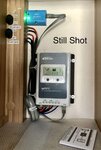I recently purchased and installed a 340W solar panel kit along with a charge controller and then later a 100Ah lithium battery. I initially tried running it with our 75Ah lead acid battery but got too close to running the battery below 50% both evenings we tested it so went for a 100Ah lithium. I also added a 300W pure sine inverter for the laptop and changed the 10W halogen bulbs for 1.2W LEDs in the lighting at the same time as the battery upgrade.
Fridge and hot water are on gas so it’s the whale water pump, LED lighting and inverter keeping a laptop charged. We’re charging phone, ipad etc via USBs on the charge controller in the morning when we have some solar energy coming through.
I thought the 100Ah lithium would give us a lot more usable energy than the 75Ah lead acid battery, approximately 3 times the amount so comfortably make it through an evening, however the first night I tried the new setup I was back to low battery and battery anxiety by 9pm, the voltage had dropped from 14.5 to 13.0 in the space of 2 hours using 4 1.2W lights and occasional water running for rinsing cups etc.
In the morning we were back up to 13.3, it’s been a fairly cloudy day so wasn’t expecting a quick charge. It’s been up and down 13.9 one time I checked it then back down to 13.5 the next. Running the water seems to make the battery voltage drop pretty quickly.
Totally new to solar so this may be just a bit of anxiety on my part. My fear is that I have a duff battery. My question is does anyone here have a similar experience and also is there an easy, quantifiable way to test battery health?
Fridge and hot water are on gas so it’s the whale water pump, LED lighting and inverter keeping a laptop charged. We’re charging phone, ipad etc via USBs on the charge controller in the morning when we have some solar energy coming through.
I thought the 100Ah lithium would give us a lot more usable energy than the 75Ah lead acid battery, approximately 3 times the amount so comfortably make it through an evening, however the first night I tried the new setup I was back to low battery and battery anxiety by 9pm, the voltage had dropped from 14.5 to 13.0 in the space of 2 hours using 4 1.2W lights and occasional water running for rinsing cups etc.
In the morning we were back up to 13.3, it’s been a fairly cloudy day so wasn’t expecting a quick charge. It’s been up and down 13.9 one time I checked it then back down to 13.5 the next. Running the water seems to make the battery voltage drop pretty quickly.
Totally new to solar so this may be just a bit of anxiety on my part. My fear is that I have a duff battery. My question is does anyone here have a similar experience and also is there an easy, quantifiable way to test battery health?


